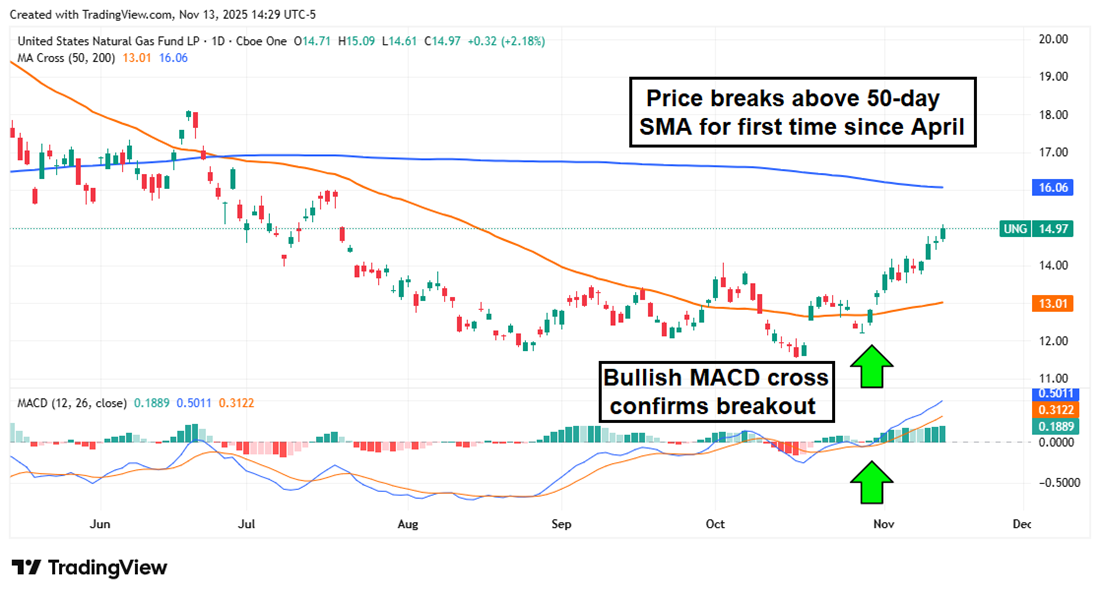|
|
|

|
|||||

|
|

Winter is coming, and this became apparent last week as brisk temperatures descended on many northern states as the calendar flipped to November. The first blast of arctic air usually gets Americans thinking about holidays and family gatherings, but surging energy prices are also top of mind, and power demand is likely to increase with experts projecting a bitter winter. One beneficiary of rising energy prices has been the energy sector itself, and few sources have seen larger price jumps than natural gas, which currently sits near multi-year highs. If high utility bills are biting into your income, bite back with some investments in natural gas companies. Today, we’ll discuss some different ways to add natural gas exposure to your portfolio through equities.
A cold winter is nothing new, especially if you live in the northeast and got mountains of snow dumped on you last year. However, it’s not just cold temperatures this time around; a confluence of factors is driving natural gas prices higher, some of which lack easy affordability solutions. The unit cost for natural gas, known as the Henry Hub price, spiked to $4.94 earlier this month, the highest price since Russia’s invasion of Ukraine began in 2022.
Why is natural gas leading the energy pack? Here are three primary reasons:
When natural gas prices rise, there are two primary ways for investors to gain exposure: equities and futures contracts. Futures contracts are advanced trading instruments that require margin and specific accounts to trade, but luckily, you can simulate that same exposure through ETFs in your standard brokerage account.
If you want clean-cut spot price exposure, you’ll probably want to consider the United States Natural Gas Fund (NYSEARCA: UNG).
Designed by United States Commodities Fund LLC, UNG uses short-term futures contracts to track the Henry Hub spot price as closely as possible. T
he fund holds a mix of natural gas futures and cash and charges a 1.01% net expense ratio, which is high, but also the cost of doing business if you want pure-play exposure through futures.
The UNG chart highlights the recent uptrend in natural gas prices.
The share price crossed over the 50-day simple moving average (SMA) with strong momentum for the first time since the spring, and the MACD shows further momentum brewing with its own bullish crossover.

One of the main theories behind ETFs is that if you can’t pick the winners consistently, you might as well buy the whole market. That’s what you’ll get with the First Trust Natural Gas ETF (NYSEARCA: FCG), which offers exposure to a variety of important companies in the natural gas industry. It doesn’t track the spot price as well as UNG, but it provides a different type of exposure, and you’ll pay much less (a 0.57% expense rate) to own it.
Some of FCG’s holdings include EQT Corp. (NYSE: EQT), the largest U.S. natural gas producer by volume, and Western Midstream Partners LP (NYSE: WES), a large-cap midstream company that operates in natural gas and crude oil.
The fund’s index is carefully constructed by identifying domestic companies that meet certain natural gas reserve thresholds and ranking them into a top 30 list using a four-part methodology. The fund’s holdings are reviewed and rebalanced quarterly.

Before you make your next trade, you'll want to hear this.
MarketBeat keeps track of Wall Street's top-rated and best performing research analysts and the stocks they recommend to their clients on a daily basis.
Our team has identified the five stocks that top analysts are quietly whispering to their clients to buy now before the broader market catches on... and none of the big name stocks were on the list.
They believe these five stocks are the five best companies for investors to buy now...
The article "Natural Gas Is Surging—2 ETFs to Help You Profit" first appeared on MarketBeat.
| 5 hours | |
| 9 hours | |
| Dec-04 | |
| Dec-04 | |
| Dec-03 | |
| Dec-03 | |
| Dec-03 | |
| Dec-02 | |
| Dec-02 | |
| Dec-01 | |
| Nov-27 | |
| Nov-25 | |
| Nov-24 | |
| Nov-24 | |
| Nov-20 |
Join thousands of traders who make more informed decisions with our premium features. Real-time quotes, advanced visualizations, backtesting, and much more.
Learn more about FINVIZ*Elite